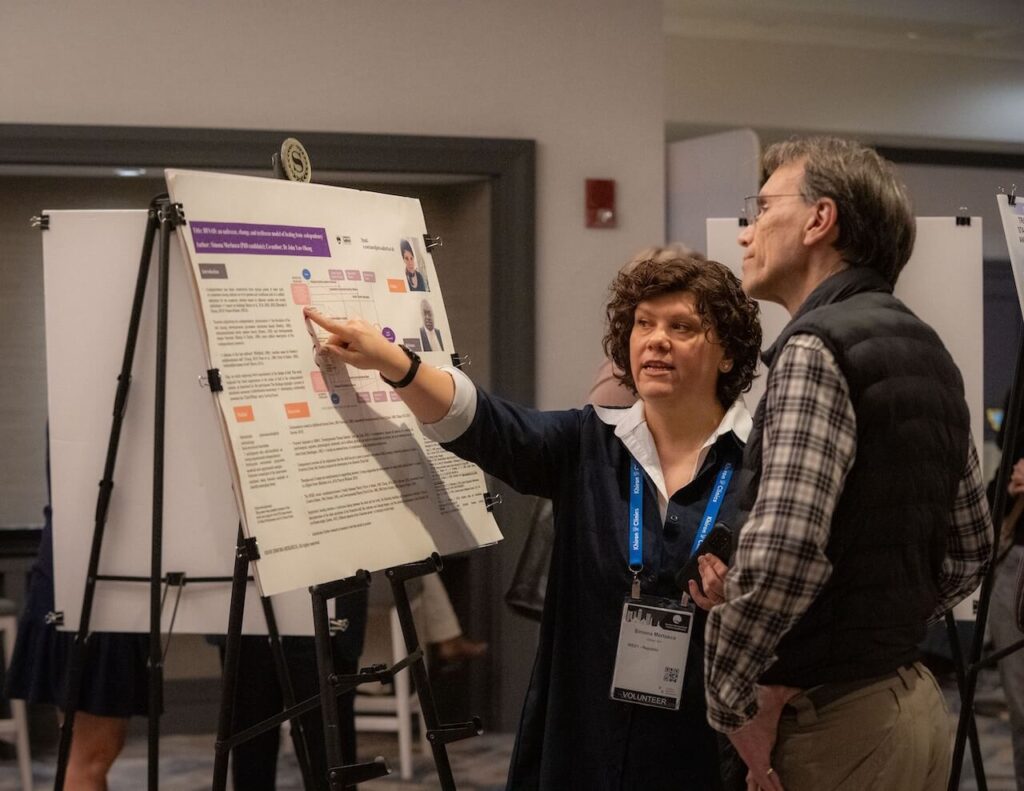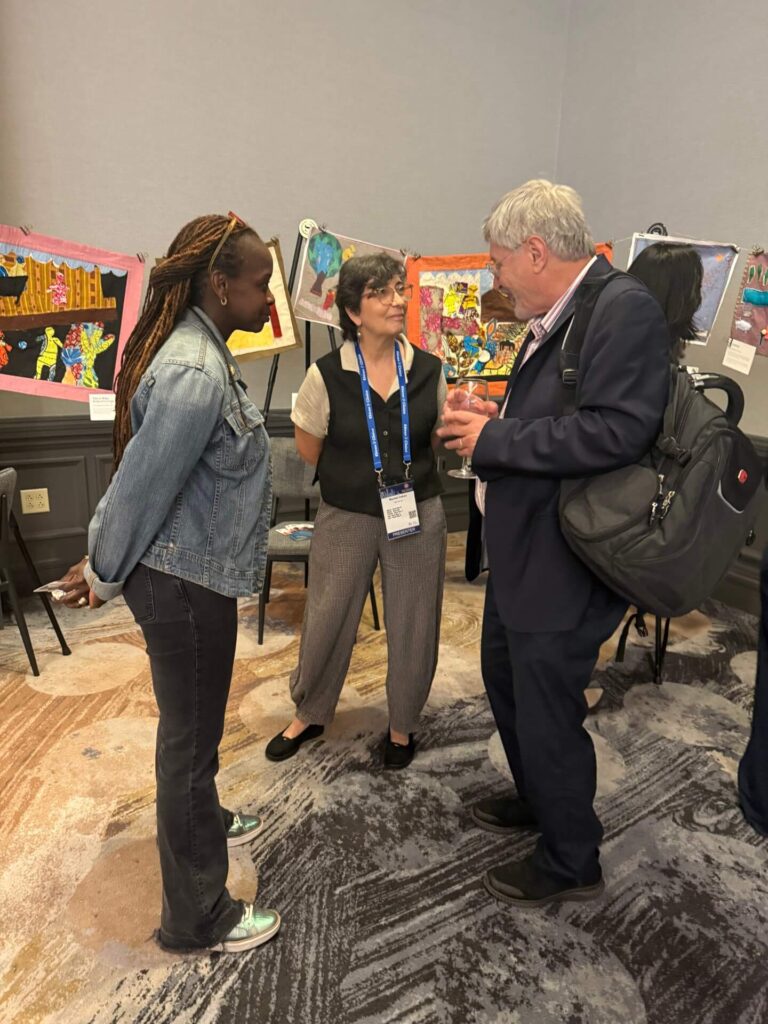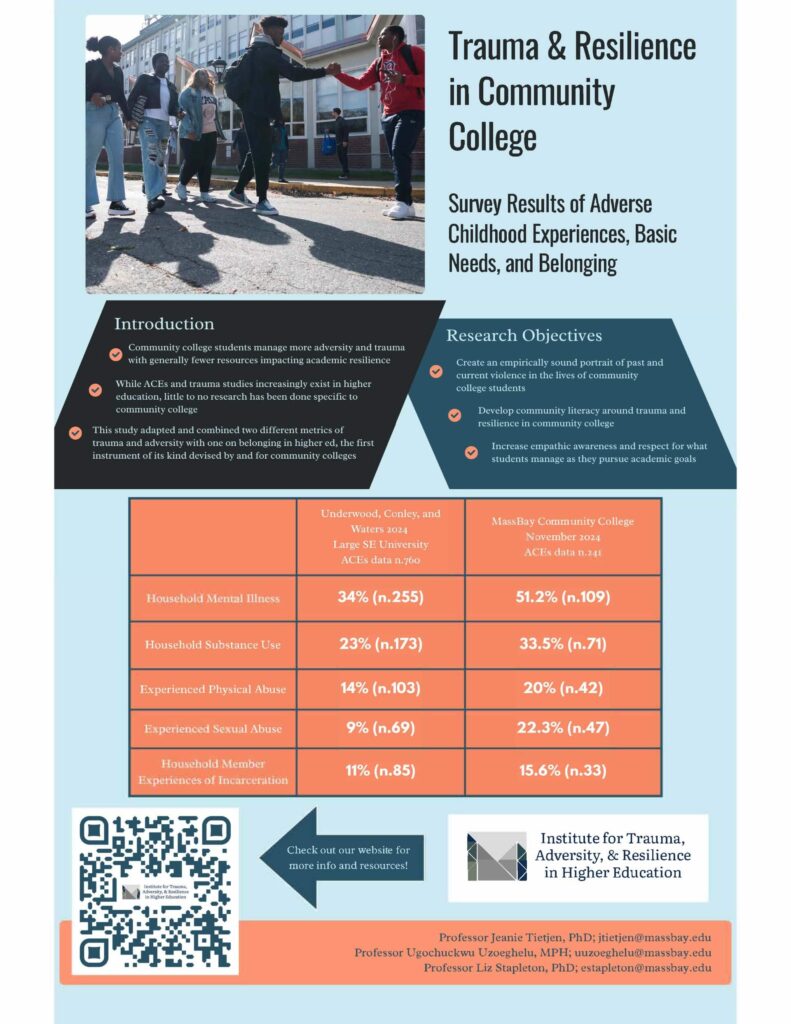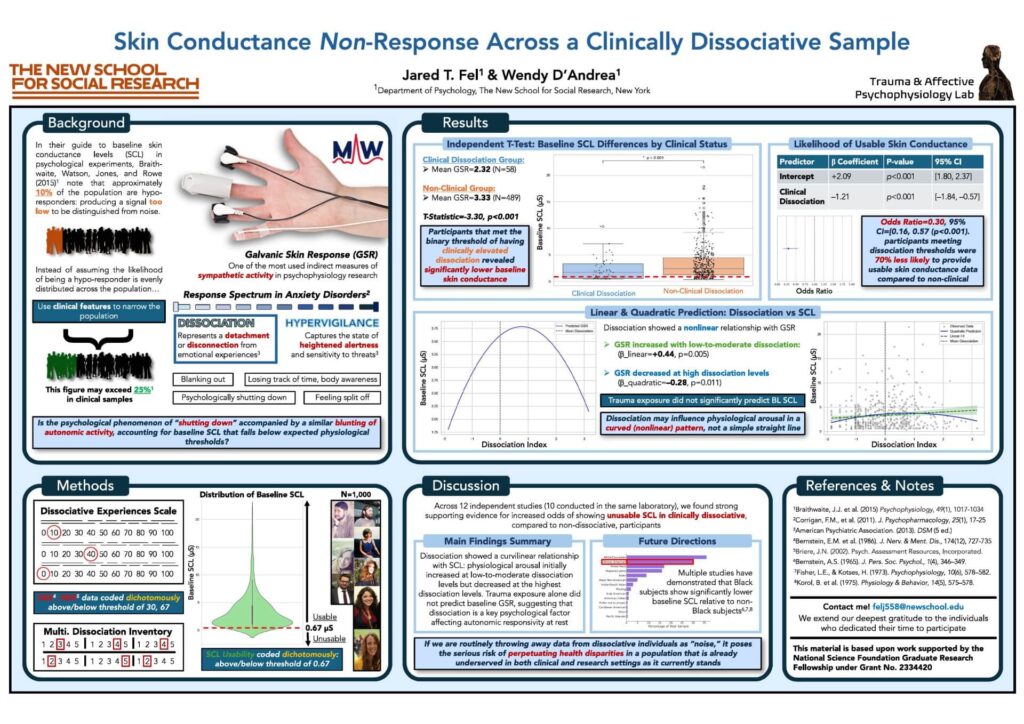Collaborators
At the Foundation’s 36th Annual Boston International Trauma Conference in May 2025, researchers from around the world shared groundbreaking insights and advances in trauma science. Below you’ll find highlights from selected poster presentations that showcase their incredible work.
BFSAD: an unfreeze, change, and (re)freeze model of healing from codependency
Presenter: Simona Merlusca
Overview: This proposed model combines some of the most common theories used throughout the codependency literature (Bowen’s Family Systems Theory, Attachment Theory, and Developmental Theory) to explain codependency, and form the basis of interventions supporting people who have experienced codependency. This model is based on the findings of my hermeneutic methodology study exploring the experiences of sense of Self in the codependency context.
The model brings into practice the theoretical Transcendental Codependency Model in my study, which highlights that healing involves the transition from falsehood to authenticity, from a Protective (False) Self to an Authentic (True) Self. The healing journey involves a continuous dialog between the mind and the body, the didactic teaching and experiencing methods, a cycle of deconstructing the Protective Self (the unfreeze and change stages), and the gradual consolidation of the Authentic Self (re/freeze stage). Different aspects of the 3 theories above are at interplay at each stage.

Transdiagnostic Group Psychotherapy For Phase 1 Stabilization And Symptom Reduction Integrating Emdr And Sensorimotor Psychotherapy: Preliminary Findings
Presenters: Luis Eduardo Estévez Cachafeiro and Inma Ferrero Macías
Institution: The Sant Andreu Adult Community Mental Health Center (Barcelona), part of the Vidal i Barraquer Foundation
Objective: This study presents preliminary results on the efficacy and satisfaction of a group psychotherapy intervention for the Stabilization and Symptom Reduction phase of the Adverse Life Experiences and PTSD Intervention Program within the Primary Care Collaboration Program.
Method: Participants included patients diagnosed with PTSD, Complex PTSD and other trauma-related psychopathologies. The intervention consisted of a semi-structured 10-session group therapy based on EMDR and Sensorimotor Psychotherapy. Outcome measures included the Detachment and Compartmentalization Inventory (DCI), CORE-OM, Beck Depression Inventory (BDI-II), and PTSD Symptom Severity Scale-Revised (EGS-R). Satisfaction was also assessed.
Results: Significant improvements were observed across all CORE-OM subscales, along with notable reductions in depressive and PTSD symptoms. Over 80% of participants expressed high satisfaction with the treatment.
Conclusions: Preliminary results suggest that the intervention is effective in reducing PTSD and stress-reactive symptoms, making it a valuable initial intervention within a trauma-focused program in the Public Health Service.

Life Stressors, Trauma, and Resilience in Community College Students
Presenters: Jeanie Tietjen, Elizabeth A. Stapleton, Ugochukwu Uzoeghelu, David Bamat.
Abstract: This poster shares data from the first administration of a survey of community college students (39% of all undergraduates in the U.S.) that forms a powerful portrait of basic needs, adverse childhood experiences, and resilience-building factors in students’ lives. Trauma, adversity, and violence affect academic resilience, and yet, too often, past and current forms of violence are incorrectly framed as issues outside the classroom and configured as individual rather than community and systems-level concerns.
While traditionally defined academic skills are critical, misperceiving the problem of violence and how it presents in our community and classrooms decenters core issues, ultimately undermining interventions and supports.
When colleges do not understand what students experience, they might not appreciate the real issues students face, and colleges can better serve students when they have a better sense of what students have had to manage and deal with as they pursue their educational goals. The poster represents early data from an ongoing survey of community college students on basic needs, adversities, ACEs, and college belonging/resilience.
ACEs data is rarely collected in community college students, and not in coordination with Basic Needs Insecurities, and while trauma-informed practices are growing in higher ed, the movement is yet quite new, and this data serves to better understand what community college students are managing.
Our study’s findings on ACEs reveal that our student participants face significant barriers both inside and outside the classroom. A notable 51.2% of students reported a history of household mental illness, and 33.5% experienced a household history of substance use disorder. Participants also reported direct experiences with personal abuse: 20% experienced physical abuse, and 22.3% experienced sexual abuse. Additionally, 15.6% of students reported a household member with involvement in the criminal justice system.
These findings underscore the elevated exposure to various forms of ACEs within the community college student population, highlighting a critical area for targeted support and trauma-informed interventions.
The Fabric of Healing, Common Threads Project
Presenters: Rachel A. Cohen and Adeyinka M. Akinsulure-Smith, Ph.D., ABPP
Overview: Common Threads Project, an organization dedicated to supporting survivors of sexual and gender-based violence, war, and displacement, exhibited a selection of story cloths at the Boston Trauma Conference in May 2025. These story cloths allow the makers to express their experiences gradually and safely, to connect to their cultural origins, to externalize and transform their pain, and to be understood and supported by others in the circle. When this narrative work is paired with the deeply self-regulating, slow, rhythmic action of hand stitching, it allows the participants in the healing circles to tolerate trauma processing. Looking at the story cloths allows the observer to bear witness, to validate the survivors’ experiences, to connect with both their suffering and their profound resilience.
The model is informed by ancient cultural practices and current neuroscientific understandings of trauma treatment. After developing safety and stabilization, participants in CTP circles learn to create story cloths as visual representations of their unspeakable experiences. Because war trauma disrupts all domains of human experience – body, emotions, social relationships, cognition, and spirit – this intervention is designed to be multi-dimensional. The program also incorporates artmaking, somatic resourcing techniques, community building, psychoeducation, and self-regulation skills to foster meaningful and enduring recovery. Trauma is addressed where it lives – in the realms beyond verbal expression.
Launching projects in several conflict affected regions over the past decade (Ecuador, Nepal, Eastern DRC, Bosnia, Nigeria, Ukraine, and in urban refugee communities in the US), we collaborate with existing community organizations who adapt and implement the model for their context. Preliminary mixed method pilot studies have shown the program to be effective in reducing mental health suffering, improving functioning and resilience, overcoming shame, stigma and self-blame, regaining connection to others, rebuilding a sense of meaning and purpose, and developing voice and agency.

Skin Conductance Non-Response Across a Clinically Dissociative Sample
Presenter: Jared Fel
Abstract: Skin conductance (SC) is a commonly used indicator of sympathetic activity in psycho- physiology. In their guide to using SC in psychological experiments, Braithwaite, Watson, Jones, and Rowe (2015) note that approximately ten percent of the population are SC hypo-responders, producing a signal that is too low to be distinguishable from noise.
The likelihood of being a hypo-responder, however, is not evenly distributed across the population, and researchers have more recently begun to investigate whether there are systematic differences in proportion of hypo-responders among clinical subgroups.
The present study investigated whether clinical dissociation disproportionately accounted for baseline recordings of SC below expected physiological thresholds. This was explored using a dataset comprising baseline data compiled across six independent dissertations conducted at the Trauma and Affective Psychophysiology Lab at The New School.
We found strong evidence supporting this primary hypothesis, revealing that clinically dissociative participants across the six studies had significantly lower odds (70.3%) of producing usable SCL data compared to their non-clinically dissociative counterparts.
This lends support to the notion that participants endorsing clinically significant dissociative symptomatology will be disproportionately excluded from SC analyses and results as outliers (i.e., “noise”), due to falling below established threshold values.
Photo credits to Mary Frangie
A gift to Trauma Research Foundation helps expand the field of trauma treatment by increasing awareness and providing access.
Please note we do not have a telephone number. To contact us please use the form on our general inquiry page

